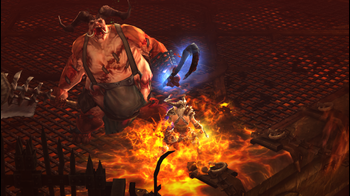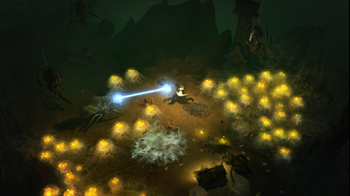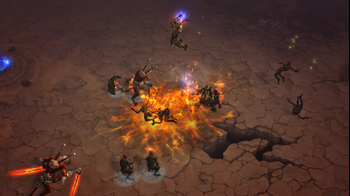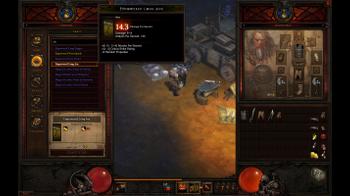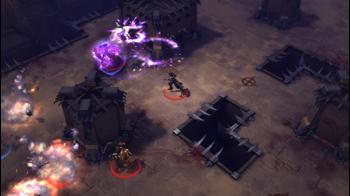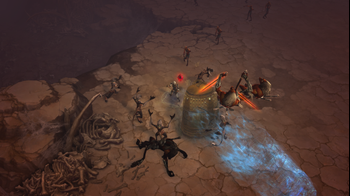Diablo III Review
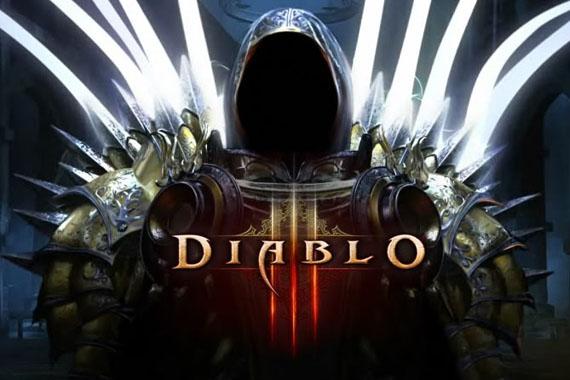
Okay, let's get this bit out of the way first: We're not going to be talking about the server problems in this review. They're already very well-documented online and we're going to assume that by the end of this month they'll be resolved. If you don't know, Diablo III includes always on DRM which means you need to be connected to Blizzard - even to play alone.
I'm as guilty as anyone of complaining about this on Twitter and other avenues, especially when I first started playing and was almost immediately booted from the game, but here we're going to focus on the game itself. Blizzard's DRM policy and their failings with this launch are both things that deserve scrutiny, but we won't do it here - there's an article for another time. Just know that the game's servers were horribly broken at launch - but that was the king of the very few problems there are with Diablo III.
Diablo III takes place twenty years after the events of Diablo II. After destroying Baal, the last of the Prime Evils of Hell and the bringing of salvation to humanity by the archangel Tyrael, everything seemed to be at peace for the first time in ages. Unfortunately, the good times appear to be over. As Diablo III begins fan favorite Deckard Cain his pouring over ancient tomes inside of an old dilapidated cathedral standing in the remains of Old Tristram, prophesizing about how the End Times may be closer than what was once believed. Some sort of 'Star' is seen falling from the heavens above and crashes into the cathedral, trapping and allegedly killing Deckard Cain. His niece, Leah, witnesses this event and hurries to New Tristram to try and get help.
The story setup is swift and succint, and after a short amount of time that's punctuated with some absolutely beautiful and expensive-looking CGI, the game proper begins, placing you into the boots of an unnamed hero who is yours to fully and completely customize.
From the outset the game gives you a choice between five diffferent character classes - The Monk, the Witch Doctor, the Wizard, the Demon Hunter and the Barbarian. They all fill pretty traditional dungeon crawling and RPG tropes - the Wizard has the elemental spells, the Demon Hunter is a master at ranged attacks, the Barbarian gets up close while the Monk combines similar stopping power with a suite of support spells. The Witch Doctor is essentially a Necromancer by another name.
For my initial playthrough I decided to keep it familiar, going with the same character I used during the beta period earlier in the year - the Monk. The concept of beating the shit out of hellspawn is appealing enough - but he's also voiced by the same person as Dynasty Warriors' Lu Bu. He's a total badass, and makes the idea of hacking and slashing my way through thousands of evil minions that much more hilarious. Give the man his damn Red Hare already!
A badass looking and sounding character is one thing, but Blizzard's presentation is in general top-notch across the board. The earlier-mentioned CGI is beautiful and the environments are lovely in their differing degrees of decrepitness. Diablo III exudes this sense that everyone on the project worked at the top of their game on a genre they'd help define.
One of the bigger complaints about Diablo III around its reveal was the decision to have a wider color palette. The argument was that a colorful game about demon hoardes from hell wouldn't work - and Blizzard even acknowledged the complaint in an April Fools prank. The final version of the game certainly does contain far more shades of color in the series' transition from a flat shading to 3D texturing and rendering, but it only serves to provide a much more realstic depiction of a Hell-scorched world littered with creatures of varying horridness.
The power of the atmosphere in the game is staggering, with the lighting and shadowing being a particularly notable star of the show in terms of building atmosphere. Each place I came across felt like it was filled with personality and had small but recognizable traits that kept the game from looking like it reused too many assets. Best of all, despite the notion that we are talking about a sequel to a game released over a decade ago, the world definitely still looks and feels like a Diablo game with its uniquely individualistic - but changed - art style.
The combat in the game is a high octane burst of fluid action sure to capture a player's attention, feeding into the particularly tight feedback loop that has become a staple of the Diablo series. It's all about taking down fools, getting loot and upgrades, and using those upgrades to lay waste to more demons. It's an incredibly tight loop, and it works as well as ever.
Right at the beginning after leveling up my monk, I was already unleashing bursts of explosive energy that included devastating hooks and a torrent of kicks, all the while having bolts of electricity dancing off my fingertips on each strike. The game does a pretty decent job at providing a lot of fun skills early on to make players feel immensely powerful even in the face of the worst creatures that the character comes across.
Physics-based gameplay also plays an important part in Diablo III and for me provided another chance to show off how big of a badass my character was in the world. Houses and other structures can be razed to the ground and traps can be triggered with a nice strike to take out of unaware monsters that just happen to be lurking around the corner. Certain enemies in the game can summon rock walls to block my character in and keep me from ripping enemies that are just out of reach apart - though only for a brief moment before I shatter the barrier and pummel them to death.
The skill tree is rich and varied with a plethora of skills for each class, meaning two players playing the same character can take entirely different approaches. It's all more user-friendly, too, with Blizzard building in a 'recommended build' option that automatically levels up with a suggested load-out for players who don't want to spend a lot of time and energy juggling stats and skills.
The system is in general streamlined, doing away with concepts like 'adding a point to strength' and other meaningless numbers. It makes character progression all about the big-effecting skills, which is far easier to grasp. However, the option for more hardcore players who are into sitting down with a pad and pen figuring out those logistics by staring at a detailed character sheet of numbers and figures found in the inventory menu does exist as a checkbox in the options menu, what the game calls "Elective".
I appreciated that the developers do cater towards both play styles, but with both auto leveling and the and the flatter skill tree the game does consequently give off a bit of an impression that it isn't as deep or as dense as the original entries into the series. It scratches the same itch as those games, though, and certainly does not go as far in its 'streamlining' as, say, Bioware's Mass Effect has.
Skills in the game are broken down by class first off. That includes two Primary Skills (known as Mouse Skills because they're mapped to your left and right clicks); Secondary, Defensive, Focus, Mantras Skills (which are laid out on your Action Bar at the bottom of the screen and mapped to the keypad as 1-4) and Passive skills which are basically latent bonuses for the character.
The keys can be mapped differently, but those are basically the ones you will be using in battle. Each skill has a "Rune", or a modifier, that makes them behave differently and provide bigger benefits as you level up your character. With Elective mode enabled, I can move the different skills around on the action bar to a layout that suits me the best.
For example, a simple skill would be able to create a whirlwind that can blind characters. After obtaining a couple more runes I can blind or have a chance to charm the enemy into fighting for me. This is basically Diablo III's version of a skill tree - but it's presented on a flat plane which makes it easier to interpret. It works well, but unlocking a ton of different runes at once definitely have me sitting there for a few minutes jumping between the different skills to settle on one that worked for me in that situation.
What becomes a failure of the game is its ability to explain that with all of these skills, you aren't forced to choose just one from each category. In actuality, with the aforementioned Elective mode enabled, you can select multiple skills from the same category and have them mapped to your mouse and keyboard. So if I wanted to, all of my mouse clicks and keypad presses can be Primary skills. None of this is really explained in the game and winds up making players make difficult decisions when the game doesn't actually require it. It's just an unfortunate case of poor tutorializing.
After I'd experienced that revelation I was able to radically alter the way I approached combat. I could map my left mouse click to attack a swarm of enemies that have piled up around me and the right mouse click to do a spinning kick to knock them away if they became too oppressive, for instance. Suddenly, it clicked and was better.
That it took a little research to discover how to change the dynamics of battles for good is troublesome, but at least there is a way to enable it in the first place, and playing around with the different combinations of skills to find one that can transition fluidly into the next while providing the most Spirit energy for my monk can be rather enjoyable.
One of my favorite features is the game is how it handles its extended Lore. Diablo's had novels and has a rich lore - and conveying all that in a game isn't ideal. As I came across new baddies in the world, a box would pop up saying, "New Lore". Hitting it would play a voice track discussing certain origins, characteristics, and motivations that each monster had.
It actually made me wish more games had this function where instead of having to go deep into some sort of compendium it was just read out loud to you so that the flow of the game wouldn't be broken just so you can find what in the hell that was that just careened into your body going 100 miles an hour and what other attacks I should be looking out for. "Lore" also contains the explanation on key characters, different journals that can be found throughout the world, descriptions of the towns and landmarks, and the quests given to complete.
Much like in previous Diablo games, there's an option to hire a mercenary to bring along with you on your travels. This time around these misfits don't cost you a single gold coin. Players have the choice between a Templar, a Scoundrel and an Enchantress.
These characters will level up alongside you, and you also have the ability to equip a different weapon on the character, give them new skills that had been unlocked as they leveled up and so on. The point is to try and get that perfect compliment to my own character's strengths and weaknesses on the battlefield, and in lieu of co-op with a real player this will give you a very helpful ally.
As a Monk, I was always in the thick of battle and would sometimes get beat up by enemies from afar. I taught my Enchantress a skill that, when used, put a protective barrier around me that repelled any projectives coming at me and even healed me as I stood inside the bubble. This becomes absolutely key later in the game when the strength of the enemies I faced grew and things started to become more difficult.
Thanks to skills such as that barrier, I was able to focus on the beast that was in front of me and not the enemy lurking just a little off in the distance. They also handle themselves quite well in battle thanks to the aforementioned ability to customize them how you want - I didn't have this feeling that my assistant was just getting in the way of my duties.
The inventory grid returns in this game but like progression is streamlined and more managable as a result. Instead of pieces of armor or giant polearms taking up a massive amount of space in your bag, each item now instead either takes up one or two spots on the grid. With 60 slots in the inventory screen, it doesn't happen often where I am forced to throw several items away in order to make room for more equipment.
There does come a time where I have to spend a minute or two chucking things out of my inventory, especially when I was heavy into the bottom floors of a dungeon, but the choices are made rather easy for me when it shows how much that spare loot is worth if I sold it to a merchant, and the fact that on a pretty frequent basis I came across equipment that is much stronger than what I currently have on my person as a part of Diablo's very tight feedback loop.
Plus, when I was picking up over 100 gold pieces a pop from enemy drops letting go of that helmet worth only 150 pieces is clearly not a difficult decision. Unlike games like Torchlight and Deathspank, there is no option to send some creature back or to automatically sell away junk loot, but considering the majority of items I picked up off the ground that wasn't colored was worth maybe 5 gold tops if sold in town, it wasn't really worth putting into my inventory and selling away later in the first place.
It certainly was worth it keeping some of the color-coded, magically-embued items, though - because I could go to an artisan and break down whatever I had into materials to craft bigger and stronger equipment to use later in the game.
After unlocking the Artisan through one of the first quests of the game, I could use him to break down items and build them up into different forms of weapons and armor. I could even train him to make him far more capable by unlocking new recipes. Although I leveled him up a bit to where I had a lot of different recipes to choose from, I am not really the type of person who spends a lot of time crafting items until after I have already beaten the game once and just want to see how impressively built my player can become.
Yet here there's plenty of motivation to invest in the Artisan. Only a few hours into the game and I was already seeing items that had multiple times the armor rating than what I currently had equipped, many of them better than anything I had found out in the world. Of course I'd need the ingredients and a little bit of gold to create them. I could also could obtain dye that would allow me to color code all of my equipment if I so desired.
Speaking of merchants the fabled Real-Money Auction House still hasn't gone up for players to try their hand at economics with as of this review. When it does launch, it'll feature a ton of ways to filter what you're looking for, which is currently the case for the in-game money auction house that's already online.
Early on in my time with the game there were times where I was able to access the game and not the auction house and vice versa, so they appear to be on different networked servers. This feature is something I will probably never become too engrossed with considering everything in the Auction House is obviously what I can find in the game itself, but controversies aside, it is there as an option for those that want to use it and one I can't logically complain about.
People may find more to complain about when the time comes for the Real-Money version to launch, but even then, people will just be arguing based on principle. Unless you're way into multiplayer PvP, there's really no reason why you couldn't save all your money and build up your character just as well as the person who spent their paycheck getting that rare set of armor which makes the whole debate a little pointless in my opinion.
It will certainly take a lot more work at the Artisan than just simply buying the item outright to expedite the process, but then again, no one should be complaining about the Auction House if they didn't want to become heavily invested into the experience of the game in the first place.
Cooperative Play is rather straightforward. Right off the bat you have the option of joining a Public Game, which is basically an option players have while they are in the game to open it up for others to help them out. An additional option is to add players to a buddy list that sits at the bottom right of the UI that updates whenever a player comes online so I could easily invite them to a game or chat with them privately at once, a feature I am very fond of when it came to organizing playtime.
Right-clicking a player allows you to see their inventory, their achievements, trade, the skills they have equipped, ascertain them the party leader, and more. When people party up, the game adjusts the strengths of its monsters accordingly much like in the other Diablo titles.
Once I was in a public game and found myself in town I was relieved to discover that the game added a banner flag feature that appears in the hometown that allowed me to jump directly to where my friend was. Previously, you'd have to play around with town portals and the incorrect presumption that the one located in town was the most recent one summoned.
A neat new addition is that instead of having to make a mad dash for loot as it appears each character has their own that appears in the game for them to grab at their leisure, so there isn't any reason to squabble over who gets the rare weapon that popped out of the boss or all the money littering the ground. Each player doesn't even see the other's loot. Experience is shared, and it appeared there wasn't any division going on in that regard; each enemy I took out, my coop partner received the same amount of XP he would have obtained had he been the one to kill it, which I bet could make power leveling a very prominant feature in the game.
I also liked that if I hopped out of a coop game I could still see the chat bar and story items, and could also choose the Quest you want to jump to. Call me crazy, but I don't really know the benefit of going back to early parts of the game to play through a quest filled with monsters several levels below your own, but I guess given the fact that the game does adjust the difficulty of the monsters based on your current level, at least the challenge remains. Playing a game with a group of four players can be all at once chaotic but also damn fun. Because monsters do scale, there's a lot of depth to be found and always the motivation to revisit areas to attempt to gain more experience and obtain better loot.
The sound design hits near perfection which has become a bit of a regular hallmark of the series. Emmy Award-winning composer Russell Brower brings a fantastic body of work here that travels from sweeping to majestic whilst hitting all of the right notes inbetween. Even the overture that plays while sitting at the main menu waiting for that pesky error 37 screen to go away is absolutely fantastic. I can imagine myself sitting in a small room, headphones on, and just letting life simply pass me by as I listen to the soundtrack and become fully engrossed in the experience.
Every punch and kick that my Monk threw had this thunderous boom that would radiate across my speakers, and the sound design in general is impressive. For a game set from an isometric-like angle the sound design is incredibly evocative. Sounds like the creeking and snapping of twigs as a Wood Nymph rips itself out of the ground are memorable and also serve as great cues for what's incoming. It is through this strict attention to even the smallest of details that allows you to become truly enveloped into the world that Blizzard has created.
But let's not forget far and away the best part - the voice acting. As I said before, I chose the Monk as my go-to because I had a great time with him during the beta. I also mentioned that he is voiced by the same man who provided the iconic sounds of Lu Bu, Jamieson Price, a man who has actually voiced a lot of characters in other RPGs including the title character in Nier and Malik in Tales of Graces f. Here, he delivers this quasi-Russian accent that had me hanging on every single word he said that showed off some of the range he truly has as a voice actor.
You also have the veteran Michael Gough as Deckard Cain (who has actually played the same character throughout the series), Jennifer Hale (Commander Shepard) as Leah and friend of the site Crispin Freeman as the Wizard; it's almost like a who's-who of the videogame voice acting world. Nolan North's probably in there somewhere, too. Every character is an absolute joy to listen to and exceptionally casted, while overall making things perfectly clear that the folks at Blizzard invested a lot of time and money to deliver the best recordings possible.
Main characters aside, my favorite actor has to be the one who plays the Scoundrel, delivering lines that seemed to be dripping in pure snarkiness. Not a minute went by when he wasn't trying to play the field with every girl he came across. At one point, I wished that my Monk leaned over and whispered into his ear, "Hey, what the hell are you doing? Stop trying to move in on my harem of women!"
As far as what the game gets wrong, I think removing the option of being able to assign points to different attributes like in previous Diablo games is a bit of a letdown. Of course, I understand that at the end of the day the loot your pick up and the gems you socket to that equipment will play the biggest part in how players will fare in the game, especially in the upcoming Player Vs. Player update. The argument can also be made that it makes the game more balanced by not having someone cramming all their points in something like strength and breaking the experience only partway into the game. It may have to do with the fact that the game now features jumo-in/jump-out coop that we may never see an option to change a player's stats, so I guess the right decision had to be made to keep things under control. Not a big strike, but I felt a little turned off by how Blizzard wasn't more upfront about both this and the "Elective" feature.
Another problem is the pace of the story. While there are certainly some truly memorable experiences to be found littered throughout the game, there are moments where things just tend to drag way too much to the point where I was hitting the space bar to skip a few lines of dialogue to get back to the meat of the Act I was currently in. The good thing is that the possibility of things like high-level loot and encountering named demons keeps even those moments from becoming dreadfully boring. I find it exciting when I am just running around on top of a tower when all of a sudden a yellow glowing beast lands right next to me with a horde of apostles under his command, making it even more entertaining when there is a piece of Lore attached with that character explaining their monumental mark on the world. I just wished there wasn't a handful of hours that felt like pure filler. At around 20 hours of game time in the Normal mode, however, there is a far greater amount of strong story content as compared to the weaker moments. And as I said, the gameplay made those moments altogether unnoticeable.

To me, the mark of a truly good game is the strength of its story and its ability to keep me thinking about it long after I have put the controller down. It may not sound like much, but there are plenty of games out there where I am sitting on my couch, keyboard on my lap and mouse next to me, and none of what is happening on the screen is being absorbed. I am just simply going through the paces to get to the end of the game.
With Diablo III, something sort of triggered in my head as I completed my playthrough and took a step away from it. As I was going to lunch, I had taken a piece of paper and a pen with me to start my initial draft of the review. As I sat at a table, the words just started flowing from my head to my hand in such a way that I haven't felt in quite a while. This is because that a lot of elements in the game became in a way instantly memorable to me.
The art direction, the orchestrated music, the voice of my character, the places I traveled to; even the user interface became . Due to the addictive nature of the game and its loot-driven madness, every so often I would think back to where I had left off with the game and how much I would love to just beat it again with every single character and look forward to simply enjoying different lines of dialogue.
My entire experience with Diablo III became one of instant admiration and recognition for those that are clearly masters of their craft, and networking qualms aside, has certainly accomplished what it has set out to become - an entry that meets and in some cases exceeds the expectations I had individually set for it and I'm sure what the millions of fans worldwide have put upon it.
Although the studio has gained plenty of flak since launch about how they handled the large influx of players, much of it certainly deserved, we may not even be having that discussion in a couple of months and instead be talking about how robust that feature actually is over all. Frequently imitated but never surpassed, Diablo III is yet another benchmark title in the Western RPG landscape.
